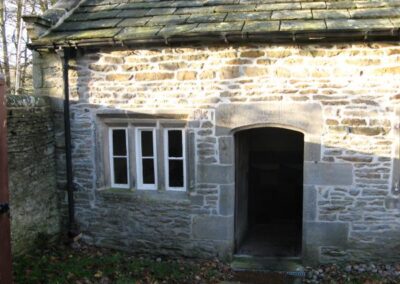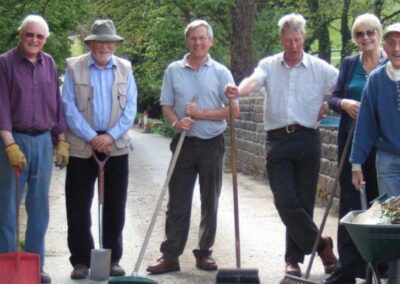Farfield Quaker Meeting House
Built in 1689 on land donated to Quakers by on a 5,000 year lease, Farfield is one of the oldest Quaker meeting houses. The 1689 Act of Toleration was an important step on the road to religious freedom that we today take for granted. Farfield Meeting House was built that same year by Quakers who had previously had to worship in secret. This small and deliberately modest building is therefore an important monument on the road to freedom of belief and religious diversity.
A lovely peaceful place, and a warm welcome
~ Farfield visitors’ book
Directions
The meeting house is on the Dales Way where it crosses the B6168 Ilkley road. Please take care as sight lines are poor. The Dales Way Association organises events and lists accommodation.
There is parking for two cars only. Please park so as not to block access to our neighbours’ houses.
Nearest rail station Ilkley (5 miles). The 74 bus operated by Pride of the Dales from Ilkley Station to Bolton Abbey Station passes the meeting house – ask the driver to let you off at Farfield by the Dales Way.
Visit
We invite visitors to leave a donation. Historic Chapels Trust is a charity with no endowment.
Visitors are welcome to eat their picnic in the small walled burial ground where there is a bench seat, but we ask you please to take away any litter with you.
In the area
The picturesque Bolton Abbey, a 12th century Augustinian Abbey in a beautiful Wharfedale setting is two miles from the meeting house. Ilkley is an attractive spa town nearby. Bettys Tea Rooms are the most celebrated of the town’s many cafes. Embsay & Bolton Abbey Steam Railway is a volunteer run steam railway 5 miles from the meeting house, offering a great day out for all the family.
Address
Two miles west of Addingham on the B6160 Bolton Abbey Road
near Ilkley
LS29 0RQ
United Kingdom
The meeting house is usually left unlocked during daylight hours. For groups please contact HCT to be sure of access.
The meeting house has a small burial ground where most of the burials are unmarked, as was then Quaker practice. However, there is also a row of five table-tombs commemorating the Myers family. It is not known whether they became Quakers, but as benefactors they must have been sympathetic at least. Table tombs are exceptionally rare in a Quaker burial ground as this style of memorial was associated with grand – even royal – burials and therefore usually an anathema to Quakers.
Farfield Meeting House was built in 1689 on land given by local landowner Anthony Myers and the date is over the door. Until that year Quaker worship was illegal and Quakers often met in the open air so they could deny to anyone who challenged them that they were a meeting for worship. Even so, two Quakers in London were imprisoned in 1670 for an open air meeting there and in Oxfordshire a wealthy Quaker was sentenced to prison for building a small stone meeting house rather similar to Farfield.
The first step towards religious freedom that we today take for granted was the Act of Toleration of 1689, when nonconformist worship was to a limited extent decriminalised. It seems likely that the local Quaker meeting around Addingham was well established in a clandestine way and they lost no time in building a stone meeting house at Farfield as soon as it was legal to do so.
Farfield Meeting House is a modest building of stone with mullioned windows. The roof is supported by a single king post truss and the floor stone flagged. Apart from benches, the only fitting is the oak stand from where the elected leaders of the meeting started and closed meetings. Quakers at that time adopted dress, manners and lifestyles of calculated simplicity, so the meeting house is in line with this – it has a ‘Quakerly’ character.
“Wood was generally left untreated, since varnish and polish were counted as vanity. Nor were there cushions, a practice that, happily, is not now regarded as essential.”
~ David Brett, The Plain Style, Cambridge, 2004
Farfield was the first project undertaken by Historic Chapels Trust. A small but historically most important building, the Quakers has ceased worship there in 1890s and the building was in agricultural use before serving as an artist’s studio in the 1950s and 60s.
Historic Chapels Trust restored the stonework of the walls and roof. We promoted an agreement to have the Dales Way diverted a few yards so that it now directly passes the Meeting House and walkers have a safer road-crossing point.
In 2018, the Friends of Farfield raised £40,000 to carry out extensive repairs and improvements to the meeting house. This included taking up the stone flag floor and laying a permable lime screed underneath, re-roofing the slates with a permable membrane underneath, refurbishment to and woodworm treatment of the original wooden benches, tying the external walls and re-plastering to the internal walls.
The unique chest tombs in the grounds of the meeting house have also just finished undergoing conservation repair to ensure that they are stable and risk of furtehr deterioation is reduced.
Today most visitors to the meeting house still come by foot, discovering the Meeting House as a small surprise along their route. Today it is listed Grade II*.
An interpretation panel on the rear wall facing the Dales Way path gives the history of the site.
This small Meeting House welcomes visitors throughout the year and is available to hire.
You may picnic in the small burial ground, but we ask you please to take any rubbish away with you.





